Thabo Beeler
ECHO: Ego-Centric modeling of Human-Object interactions
Aug 29, 2025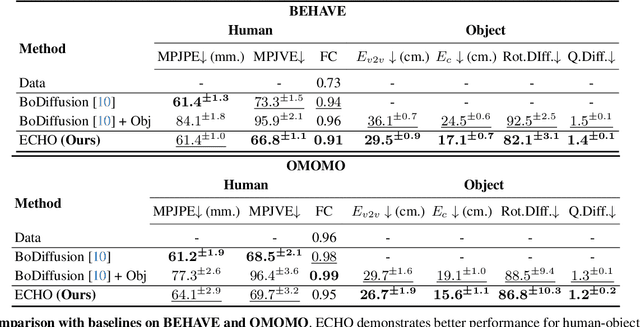
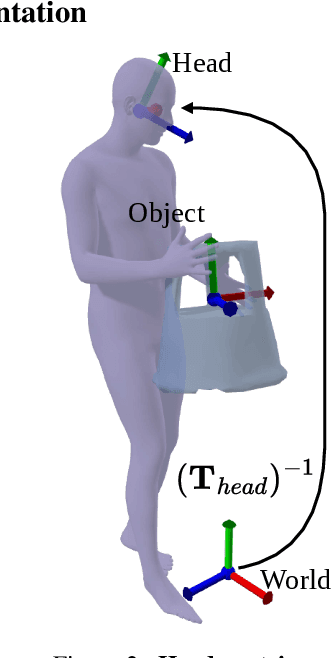
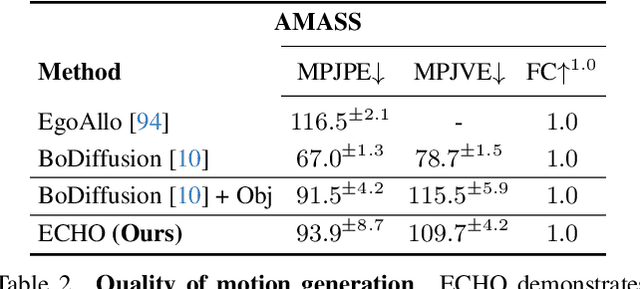
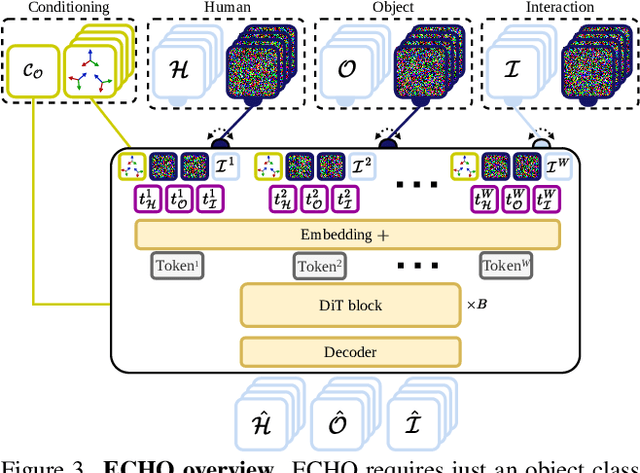
Abstract:Modeling human-object interactions (HOI) from an egocentric perspective is a largely unexplored yet important problem due to the increasing adoption of wearable devices, such as smart glasses and watches. We investigate how much information about interaction can be recovered from only head and wrists tracking. Our answer is ECHO (Ego-Centric modeling of Human-Object interactions), which, for the first time, proposes a unified framework to recover three modalities: human pose, object motion, and contact from such minimal observation. ECHO employs a Diffusion Transformer architecture and a unique three-variate diffusion process, which jointly models human motion, object trajectory, and contact sequence, allowing for flexible input configurations. Our method operates in a head-centric canonical space, enhancing robustness to global orientation. We propose a conveyor-based inference, which progressively increases the diffusion timestamp with the frame position, allowing us to process sequences of any length. Through extensive evaluation, we demonstrate that ECHO outperforms existing methods that do not offer the same flexibility, setting a state-of-the-art in egocentric HOI reconstruction.
TeGA: Texture Space Gaussian Avatars for High-Resolution Dynamic Head Modeling
May 08, 2025Abstract:Sparse volumetric reconstruction and rendering via 3D Gaussian splatting have recently enabled animatable 3D head avatars that are rendered under arbitrary viewpoints with impressive photorealism. Today, such photoreal avatars are seen as a key component in emerging applications in telepresence, extended reality, and entertainment. Building a photoreal avatar requires estimating the complex non-rigid motion of different facial components as seen in input video images; due to inaccurate motion estimation, animatable models typically present a loss of fidelity and detail when compared to their non-animatable counterparts, built from an individual facial expression. Also, recent state-of-the-art models are often affected by memory limitations that reduce the number of 3D Gaussians used for modeling, leading to lower detail and quality. To address these problems, we present a new high-detail 3D head avatar model that improves upon the state of the art, largely increasing the number of 3D Gaussians and modeling quality for rendering at 4K resolution. Our high-quality model is reconstructed from multiview input video and builds on top of a mesh-based 3D morphable model, which provides a coarse deformation layer for the head. Photoreal appearance is modelled by 3D Gaussians embedded within the continuous UVD tangent space of this mesh, allowing for more effective densification where most needed. Additionally, these Gaussians are warped by a novel UVD deformation field to capture subtle, localized motion. Our key contribution is the novel deformable Gaussian encoding and overall fitting procedure that allows our head model to preserve appearance detail, while capturing facial motion and other transient high-frequency features such as skin wrinkling.
Pixels2Points: Fusing 2D and 3D Features for Facial Skin Segmentation
Apr 28, 2025Abstract:Face registration deforms a template mesh to closely fit a 3D face scan, the quality of which commonly degrades in non-skin regions (e.g., hair, beard, accessories), because the optimized template-to-scan distance pulls the template mesh towards the noisy scan surface. Improving registration quality requires a clean separation of skin and non-skin regions on the scan mesh. Existing image-based (2D) or scan-based (3D) segmentation methods however perform poorly. Image-based segmentation outputs multi-view inconsistent masks, and they cannot account for scan inaccuracies or scan-image misalignment, while scan-based methods suffer from lower spatial resolution compared to images. In this work, we introduce a novel method that accurately separates skin from non-skin geometry on 3D human head scans. For this, our method extracts features from multi-view images using a frozen image foundation model and aggregates these features in 3D. These lifted 2D features are then fused with 3D geometric features extracted from the scan mesh, to then predict a segmentation mask directly on the scan mesh. We show that our segmentations improve the registration accuracy over pure 2D or 3D segmentation methods by 8.89% and 14.3%, respectively. Although trained only on synthetic data, our model generalizes well to real data.
Ego4o: Egocentric Human Motion Capture and Understanding from Multi-Modal Input
Apr 11, 2025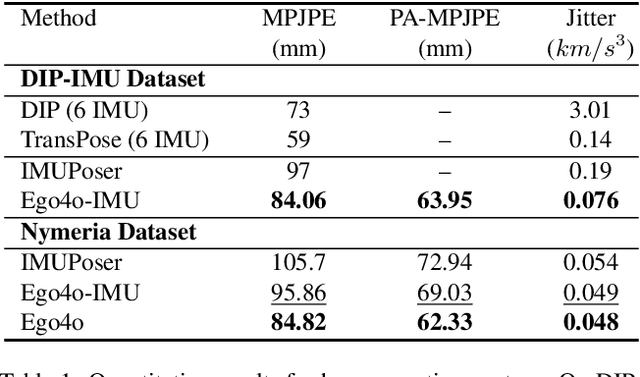
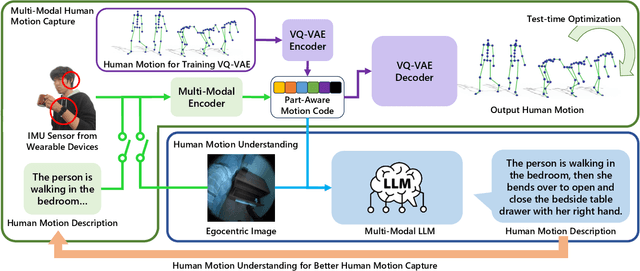

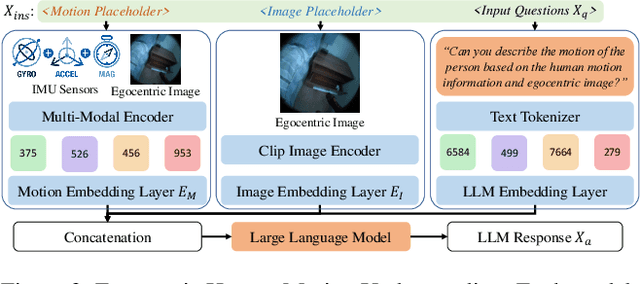
Abstract:This work focuses on tracking and understanding human motion using consumer wearable devices, such as VR/AR headsets, smart glasses, cellphones, and smartwatches. These devices provide diverse, multi-modal sensor inputs, including egocentric images, and 1-3 sparse IMU sensors in varied combinations. Motion descriptions can also accompany these signals. The diverse input modalities and their intermittent availability pose challenges for consistent motion capture and understanding. In this work, we present Ego4o (o for omni), a new framework for simultaneous human motion capture and understanding from multi-modal egocentric inputs. This method maintains performance with partial inputs while achieving better results when multiple modalities are combined. First, the IMU sensor inputs, the optional egocentric image, and text description of human motion are encoded into the latent space of a motion VQ-VAE. Next, the latent vectors are sent to the VQ-VAE decoder and optimized to track human motion. When motion descriptions are unavailable, the latent vectors can be input into a multi-modal LLM to generate human motion descriptions, which can further enhance motion capture accuracy. Quantitative and qualitative evaluations demonstrate the effectiveness of our method in predicting accurate human motion and high-quality motion descriptions.
GIGA: Generalizable Sparse Image-driven Gaussian Avatars
Apr 08, 2025Abstract:Driving a high-quality and photorealistic full-body human avatar, from only a few RGB cameras, is a challenging problem that has become increasingly relevant with emerging virtual reality technologies. To democratize such technology, a promising solution may be a generalizable method that takes sparse multi-view images of an unseen person and then generates photoreal free-view renderings of such identity. However, the current state of the art is not scalable to very large datasets and, thus, lacks in diversity and photorealism. To address this problem, we propose a novel, generalizable full-body model for rendering photoreal humans in free viewpoint, as driven by sparse multi-view video. For the first time in literature, our model can scale up training to thousands of subjects while maintaining high photorealism. At the core, we introduce a MultiHeadUNet architecture, which takes sparse multi-view images in texture space as input and predicts Gaussian primitives represented as 2D texels on top of a human body mesh. Importantly, we represent sparse-view image information, body shape, and the Gaussian parameters in 2D so that we can design a deep and scalable architecture entirely based on 2D convolutions and attention mechanisms. At test time, our method synthesizes an articulated 3D Gaussian-based avatar from as few as four input views and a tracked body template for unseen identities. Our method excels over prior works by a significant margin in terms of cross-subject generalization capability as well as photorealism.
FRAME: Floor-aligned Representation for Avatar Motion from Egocentric Video
Mar 29, 2025



Abstract:Egocentric motion capture with a head-mounted body-facing stereo camera is crucial for VR and AR applications but presents significant challenges such as heavy occlusions and limited annotated real-world data. Existing methods rely on synthetic pretraining and struggle to generate smooth and accurate predictions in real-world settings, particularly for lower limbs. Our work addresses these limitations by introducing a lightweight VR-based data collection setup with on-board, real-time 6D pose tracking. Using this setup, we collected the most extensive real-world dataset for ego-facing ego-mounted cameras to date in size and motion variability. Effectively integrating this multimodal input -- device pose and camera feeds -- is challenging due to the differing characteristics of each data source. To address this, we propose FRAME, a simple yet effective architecture that combines device pose and camera feeds for state-of-the-art body pose prediction through geometrically sound multimodal integration and can run at 300 FPS on modern hardware. Lastly, we showcase a novel training strategy to enhance the model's generalization capabilities. Our approach exploits the problem's geometric properties, yielding high-quality motion capture free from common artifacts in prior works. Qualitative and quantitative evaluations, along with extensive comparisons, demonstrate the effectiveness of our method. Data, code, and CAD designs will be available at https://vcai.mpi-inf.mpg.de/projects/FRAME/
GroomLight: Hybrid Inverse Rendering for Relightable Human Hair Appearance Modeling
Mar 13, 2025Abstract:We present GroomLight, a novel method for relightable hair appearance modeling from multi-view images. Existing hair capture methods struggle to balance photorealistic rendering with relighting capabilities. Analytical material models, while physically grounded, often fail to fully capture appearance details. Conversely, neural rendering approaches excel at view synthesis but generalize poorly to novel lighting conditions. GroomLight addresses this challenge by combining the strengths of both paradigms. It employs an extended hair BSDF model to capture primary light transport and a light-aware residual model to reconstruct the remaining details. We further propose a hybrid inverse rendering pipeline to optimize both components, enabling high-fidelity relighting, view synthesis, and material editing. Extensive evaluations on real-world hair data demonstrate state-of-the-art performance of our method.
GarmentCrafter: Progressive Novel View Synthesis for Single-View 3D Garment Reconstruction and Editing
Mar 11, 2025Abstract:We introduce GarmentCrafter, a new approach that enables non-professional users to create and modify 3D garments from a single-view image. While recent advances in image generation have facilitated 2D garment design, creating and editing 3D garments remains challenging for non-professional users. Existing methods for single-view 3D reconstruction often rely on pre-trained generative models to synthesize novel views conditioning on the reference image and camera pose, yet they lack cross-view consistency, failing to capture the internal relationships across different views. In this paper, we tackle this challenge through progressive depth prediction and image warping to approximate novel views. Subsequently, we train a multi-view diffusion model to complete occluded and unknown clothing regions, informed by the evolving camera pose. By jointly inferring RGB and depth, GarmentCrafter enforces inter-view coherence and reconstructs precise geometries and fine details. Extensive experiments demonstrate that our method achieves superior visual fidelity and inter-view coherence compared to state-of-the-art single-view 3D garment reconstruction methods.
Synthetic Prior for Few-Shot Drivable Head Avatar Inversion
Jan 12, 2025Abstract:We present SynShot, a novel method for the few-shot inversion of a drivable head avatar based on a synthetic prior. We tackle two major challenges. First, training a controllable 3D generative network requires a large number of diverse sequences, for which pairs of images and high-quality tracked meshes are not always available. Second, state-of-the-art monocular avatar models struggle to generalize to new views and expressions, lacking a strong prior and often overfitting to a specific viewpoint distribution. Inspired by machine learning models trained solely on synthetic data, we propose a method that learns a prior model from a large dataset of synthetic heads with diverse identities, expressions, and viewpoints. With few input images, SynShot fine-tunes the pretrained synthetic prior to bridge the domain gap, modeling a photorealistic head avatar that generalizes to novel expressions and viewpoints. We model the head avatar using 3D Gaussian splatting and a convolutional encoder-decoder that outputs Gaussian parameters in UV texture space. To account for the different modeling complexities over parts of the head (e.g., skin vs hair), we embed the prior with explicit control for upsampling the number of per-part primitives. Compared to state-of-the-art monocular methods that require thousands of real training images, SynShot significantly improves novel view and expression synthesis.
BimArt: A Unified Approach for the Synthesis of 3D Bimanual Interaction with Articulated Objects
Dec 06, 2024



Abstract:We present BimArt, a novel generative approach for synthesizing 3D bimanual hand interactions with articulated objects. Unlike prior works, we do not rely on a reference grasp, a coarse hand trajectory, or separate modes for grasping and articulating. To achieve this, we first generate distance-based contact maps conditioned on the object trajectory with an articulation-aware feature representation, revealing rich bimanual patterns for manipulation. The learned contact prior is then used to guide our hand motion generator, producing diverse and realistic bimanual motions for object movement and articulation. Our work offers key insights into feature representation and contact prior for articulated objects, demonstrating their effectiveness in taming the complex, high-dimensional space of bimanual hand-object interactions. Through comprehensive quantitative experiments, we demonstrate a clear step towards simplified and high-quality hand-object animations that excel over the state-of-the-art in motion quality and diversity.
 Add to Chrome
Add to Chrome Add to Firefox
Add to Firefox Add to Edge
Add to Edge